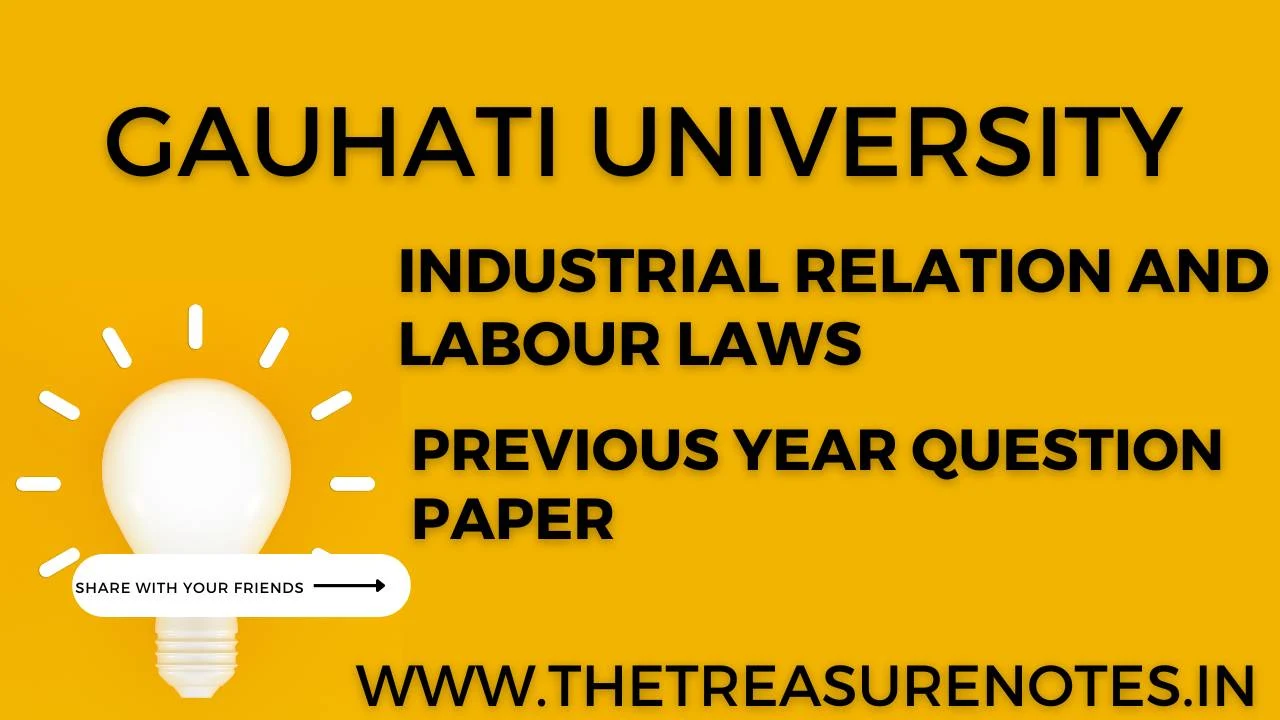In this Post we have uploaded INDUSTRIAL RELATIONS AND LABOUR LAWS Question Paper 2017, B.Com 6th Sem Gauhati University (GU). which Can be Very Useful For Your GU B.Com 6th Semester Sessional or Final Semester Examination. B.com 6th Industrial Relation and Labour Laws Question paper 2015 in PDF Gauhati University (GU).
Industrial Relation and Labour Laws Questions Paper '2017 GU 6th Sem B.com 6th Sem CBCS Pettern | Gauhati University |
Guwahati University BCom 6th semester Industrial Relation and Labour Laws question paper 2017
Gauhati University Industrial relation and labour Law Question Paper 2017
(Management Major)
2017
INDUSTRIAL RELATIONS AND LABOUR LAWS
(Management Major)
Full Marks: 80
Time: 3 hours
(The figures in the margin indicate full marks for the questions)
1. Choose the correct option from the following: 1x10=10
1) The scope of industrial relations covers
a) Relations between managers and individual workers.
b) The collective relations between employees and labour unions.
c) The role of government in the regulation of relationship between management and labour unions.
d) All of the above.
2) Which one of the following is facilitative welfare service?
a) Leave travel concession.
b) Indoor game facility.
c) Providing money to employees for purchasing of cycle.
d) All of the above.
3) Which one of the following is not a form of industrial dispute?
a) Strike.
b) On leave.
c) Boycott.
d) Gherao.
4) Which form of collective bargaining benefits both the employees and employers?
a) Distributive collective bargaining.
b) Integrative collective bargaining.
c) Attitudinal collective bargaining.
d) Intra-organizational collective bargaining.
5) Centre of Indian Trade Union (CITU) is affiliated to
a) C.P.I.
b) C.P.I.(M)
c) BJP.
d) National Congress.
6) What should be the minimum number of members of a trade union to apply for registration of trade union?
a) 5 members.
b) 6 members.
c) 7 members.
d) 8 members.
7) What should be the age of a worker to become a member of registered trade union?
a) 18 years.
b) 20 years.
c) 15 years.
d) 16 years.
8) What should be the minimum age of an office bearer of a registered trade union?
a) 18 years.
b) 20 years.
c) 15 years.
d) 16 years.
9) Lock-out under Section 2(1) of Industrial Disputes Act, 1947 means
a) The closing of place of employment.
b) The suspension of work.
c) The refusal by an employer to continue to employ any number of persons employed by him.
d) All of the above.
10) Section 46 of Factory Act imposes the obligation for canteen only when the number of workers exceeds
a) 200 workers.
b) 250 workers.
c) 300 workers.
d) 100 workers.
2. Answer the following questions in brief: 2x5=10
a) Write any two objectives of Central Board of Workers’ Education.
b) What are the usual matters dealt in the collective bargaining agreement?
c) Write any two merits of worker’s participation in management.
d) What is conciliation?
e) What is total disablement as per the Workmen compensation Act, 1923?
3. Answer any four questions from the following: 5x4=20
a) What are the objectives of industrial relations?
b) Write five distinctions between grievance and dispute.
c) Explain features of collective bargaining.
d) What are the limitations of arbitration?
e) What is retrenchment? Write the essential features of retrenchment. 2+3=5
f) Write provisions regarding employment of women under Factories Act, 1948.
4. Discuss the different approaches of industrial relations. 10
Or
Explain the importance of workers education.
5. What are the different levels of workers’ participation in management? 10
Or
Explain the concept and functions of trade union.
6. What are the matters set out in the schedule of the Industrial Employment (Standing orders) Act, 1946? 10
Or
Write any ten authorized deductions as per the Payment of Wages Act, 1936.
7. What are the various provisions regarding welfare as per the Plantations Labour Act. 1951? 10
Or
Explain the main features of the Contract Labour (Regulation and Abolition) Act, 1970 and the welfare provision of contract labour under the same Act. 5+5=10
-000-

